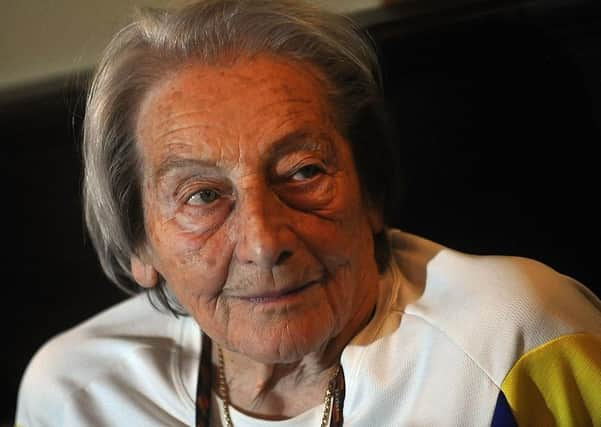Obituary: Dana Zatopkova, athlete, Olympic gold medalist for Czechoslovakia in the javelin, world record holder


Dana Zatopkova who has died aged 97 won Olympic gold for Czechoslovakia in the javelin throw at the 1952 Helsinki Olympics less than an hour after her husband Emil Zatopek won gold in the 5,000m, one of three he famously claimed in the Finnish capital. Although sometimes eclipsed by Emil’s achievements she was very much a top drawer athlete in her own right who also won silver at the 1960 Rome Olympics, was European champion in 1954 and ’58 and set a world record in ’58. They were for a while undoubtedly the world’s most famous sporting couple who not only shared Olympic gold medal status but even the same birthday.
In Helsinki as she entered the arena for her event she met her husband and took his gold medal from him ‘to bring her luck’. Whether it was down to that or she was simply inspired by his success she threw a lifetime best on her first throw which clinched the gold ahead of two Soviet athletes who had recently beaten her during a meeting in Kiev. For good measure it was also a new Olympic record.
Advertisement
Hide AdAdvertisement
Hide AdA famous photograph went round the world of her and Emil kissing trackside after her win before she performed a cartwheel of delight. The Helsinki Official Report referred to her as ‘the happiest gold medallist of the Games’.
As a schoolgirl she was a talented all round sportswoman taking part in swimming, gymnastics, volleyball and handball. In the latter she was a member of the Slovak Slavia team which won a national title.
After school she studied physical education at Brno University of Technology and continued her sporting involvement.
After the war in 1946 she attended an athletics course where she attempted the javelin throw for the first time, initially without success. When she changed her technique to hold and throw the implement as if it were a pen that brought immediate improvement leading to her going on to win the first of many national championships later that year.
In 1948 at an athletics meeting in Zlin she met future husband Emil to whom she was tasked with presenting a bouquet for setting a 3,000m record that afternoon while he had earlier done the same to her in recognition of her national record set a week previously. Shortly after they both travelled together for a contest in Bratislava which signalled the start of their romance.
Although he had qualified for the 1948 London Olympics she struggled to do so till with time running out she did so by the skin of her teeth enabling them to go to London as a couple.
She was then in the early days of an international career but London was an important rite of passage. While seventh place was commendable for her Olympic debut she drew tremendous inspiration from the experience. Later she commented: “I was so impressed by the stadium full of 100,000 people, the fanfares, the King and Queen at the Opening… it was just wonderful for me, a girl from the country. The spirit of the Olympics was palpable, it was there I started to take my sport seriously.”
Meantime Emil had won gold and silver with the couple becoming closer and agreeing to marry. Emil bought engagement rings in Piccadilly and two months later they wed on 24 October 1948 in Uherske Hradiste before setting up home in Prague.
Advertisement
Hide AdAdvertisement
Hide AdOver the ensuing seasons she improved her world ranking to fourth in 1951 and the following winter increased the intensity of her training to include throwing a 1kg iron bar as well as sprinting and jumping, to further her quest for Olympic gold in Helsinki.
European success followed in 1954 while in the 1956 Melbourne Olympics she was fourth before regaining the winner’s rostrum in the 1958 European Championships. When she set her world record that year in Prague aged 35 she was the oldest athlete ever to achieve one and the last to do so with the wooden javelin. And in the 1960 Rome Olympics she gained silver while almost 38, the oldest athletics medallist for another 40 years.
She continued to compete at a good level for another four years before switching to coaching and serving with distinction on the Womens’ Committee of the IAAF.
Her contribution to the sport was recognised with the award of the Olympic Order, the Unesco Fair Play Award and the Medal of Merit from the Czech Republic.
Dana Ingrova was born in Frystat in Moravia before the family moved first to Olomouc and then Uherske Hradiste where her father Antonin Ingr was a Colonel in charge of an infantry regiment. His association with the prewar government led to his being sent to Dachau and Buchenwald much to his daughter’s horror, a lifelong memory.
When retired from competition she worked in administrative posts in the national athletics federation while Emil rose to Colonel in the army as they built a lovely house in a Prague suburb for themselves. Life was pretty good but that changed after Dubcek’s liberalist ‘Czech Spring’ in 1968 which both publicly supported. After the Soviet invasion he was stripped of his army rank and made to work as a labourer away from home in Prague while she suffered financial and other hardships.
Seven years passed before the regime ‘forgave’ them and they were fully rehabilitated once democratic President Havel took power in 1989 when several prestigious awards were bestowed on them. Emil predeceased Dana in 2000 and the couple had no children.
Jiri Kejval, head of the Czech Olympic Committee, was quoted: “Dana Zatopkova was a role model for generations of Olympians – she was an excellent athlete but also a great person.”
JACK DAVIDSON